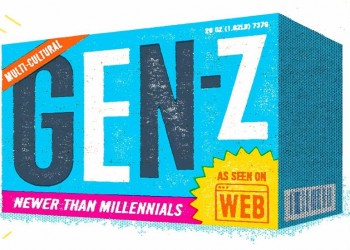As futurist speakers and trends experts, we’re frequently asked to weigh in on major socioeconomic trends impacting the globe on a grand scale – a.k.a. “megatrends” as it were. Throughout a series of several posts, we thought we’d highlight a number of these new megatrends which promise to transform the working world and marketplace in coming years including 2016, 2017, and far beyond. To kick the series off, let’s take a look at one of the most important: The changing face of tomorrow’s workforce.
Case in point: Shifting demographics in both the workplace and the market make it even more important for executive leaders and boards to fundamentally rethink how they interact and engage with future generations. You don’t have to count yourself among the ranks of futurist speakers or trends experts to note that the faces of tomorrow’s leaders are quickly changing, along with their expectations from leading business, brands, and employers.
Millennials, or Gen Yers, are the future and are today’s fastest-growing workforce and membership segments for many businesses and boards. Their habits and opinions are shaping the fundamental way in which leaders must look to support, engage with, and empower them. Gen Y is already upon us, and Gen Z fast approaching. Expectations and opinions are going to change more radically, and even faster, going forward.
The big question to ask is: What are we as leaders to make sure Gen Y and Gen Z’s voices are better being heard? And—because the way in which they process information and communicate is vastly different than prior generations—what are we doing to ensure we’re effectively connecting with them going forward?
There are dozens of conferences a year on innovation. Most conversations there aren’t centering on actual methodologies or best practices. Instead, they’re focusing on topics like human capital and corporate culture. Big themes echoed in this regard include:
- Diversity – The importance of finding ways to give younger generations and non-traditional viewpoints a voice or seat at the boardroom table.
- Incentivization – Finding ways to empower workers to speak up, take action, and make a difference in the organization. This includes the growing need to create leaders and entrepreneurial thinkers (or intrapreneurs) at every level of the organization who can consistently innovate and stay ahead of the curve.
- Training + Development – Equipping tomorrow’s leaders with the skills they need to succeed in a world of constant change and disruption—skills that are vastly different than those being taught in the past.
They’re all issues we should be considering. And if you haven’t put them at the top of your list, I highly recommend giving them more priority. To put things in perspective:
- With 75.4 million people and counting, Millennials have now surpassed Baby Boomers as today’s largest generation. In fact, they’ve now become the single largest generation in the workforce as well.
- By 2020, one in three adults will be millennials.
- What are some of characteristics define a Millennial, or member of Gen Y, precisely? And by Millennial, I typically mean individuals age 19-35. For starters, chances are they’re the ones in any given meeting who’ll look at you blankly the next time you make a joke about Atari or Ferris Bueller’s Day Off. They’re also hugely optimistic and relentlessly determined to change the world for the better.
- But most importantly these folks are digital natives. Not only have these individuals been raised on a steady diet of high-tech gadgets, online websites, and 24/7 wireless communications. They’ve also grown up in a world of constant connectivity and social networking.
A few other things to keep in mind from an organizational or employer’s perspective:
- 5 percent of millennials do not measure success in terms of money—they measure it in terms of ability to achieve goals and *most importantly* MAKE A DIFFERENCE in their business or community.
- To this point, most Millennials say they’d rather earn $40,000 per year at a job they love than $100,000 at one they hate.
- What’s more, nearly four in five millennials want to work for innovative companies and believe they’ll work for themselves at some point as well.
- Millennials now account for $1 trillion in consumer spending now—just in the U.S. alone, and are predicted to outspend Boomers by next year.
As business leaders, we have to reconsider how the organizations we work with function and communicate … and what they’re doing to attract and retain top talent— talent that may be far more diverse and demanding than any that’s come through the organization’s doors than ever before.
Gen Z may be the future, but their moment is almost here too. Amazingly, these individuals, born after 1995, are also radically even different than Millennials. Raised in an always connected, 24/7 on-demand mobile world, they not only prize personally-customized solutions and instant feedback. Having grown up in the middle of a recession, they’re also super scrappy and entrepreneurial as well. As you might imagine, and futurists speakers and trends experts can confirm, their expectations from organizations, businesses, and brands that they deal are quite unique too.
A few points to note:
- Gen Z currently represents a quarter of America’s population
- By 2020, 40 percent of customers will be Generation Zers
- They’ve got about $44 billion in purchasing power
- Gen Z is highly social, spending nearly eight hours a day interacting with friends and family
- Gen Z uses five screens on average as compared to Millennials, who use three— (smartphone, TV, desktop, laptop, and tablet).
- Their attention span lasts eight seconds—less than that of a goldfish—thanks to Snapchat, Vine, and emojis.
- Also important to note is that Gen Zers are born entrepreneurs—more than seven in 10 Gen Zers want to start their own businesses and ventures
- And like Millennials, 60 percent of Gen Zers want to make a difference in the world— topics like corporate social responsibility, personal/prof development, and innovation are becoming far more important for them than any prior generation.
Executive leaders, managers, and boards need to fundamentally rethink how they engage these individuals and work to get them involved. A few ways our clients have done this include:
- Creating Young + Emerging Leaders programs, and regularly involving them in meetings and programs
- Developing committees and expert advisory roles for these individuals
- Launching formal training and development initiatives to recruit younger talent
- Designing forums and events that encourage the open sharing of dialogue and ideas between generations
- Building online forums and portals where subject matter experts from diverse backgrounds and walks of life can come together and collaborate
- Using hackathons, internal contests, and other design challenges to identify and groom emerging leadership talent
From a leadership standpoint, generational diversity now requires us to bring different viewpoints and perspectives to the table. We note this now because the shape of tomorrow’s organization and workforce will look radically different than it does today.
Many of today’s problems are new and novel. Those with the most experience dealing with them, and in helping organizations consider how to address these challenges, may not necessarily be the most senior in the organization. As business leaders, it’s vital that we get more feedback from more sources, and encourage diversity of thought, experience, and perspective at every possible instance.
GET YOUR FREE COPY NOW!
books
Limited-Time Offer: Download Free eBook THINK SMARTER Today!
No spam. We respect your privacy.














